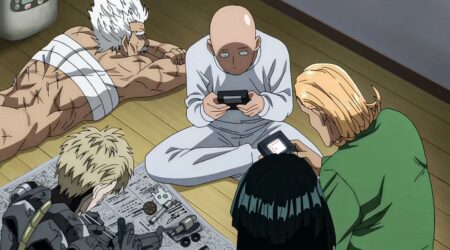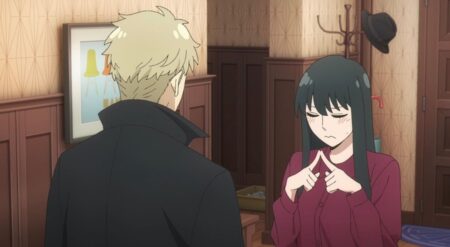With Izuku “Deku” Midoriya (Daiki Yamashita, Ragna Crimson) safely reunited with his friends, the stage is now set for the final confrontation between Japan’s heroes and All For One (Akio Ôtsuka, The Grimm Variations). But as the final pieces move into place, both sides are busy trying to gain an advantageous position for the coming battle. With new allies eager to enter the fray, My Hero Academia Season 7 from Studio Bones gets off to a running start as it builds some of the franchise’s biggest moments. Unfortunately, it isn’t always able to string its hits together as skillfully.
When we think of great anime, the first things that come to our mind are generally gorgeous animation, skillful voice acting, and big memorable moments that stick with the viewer long after the credits roll. However, there are other aspects of storytelling that we generally don’t think about as much as we should. Elements like pacing and how story elements are put together can hinder the aspects we love to talk about land. Despite My Hero Academia Season 7‘s masterful implementation of the former group, it is with the latter elements that it fails to find a proper footing.
This season wastes no time establishing the scope and power of the battles it will bring. From the opening pair of episodes that focus on the arrival of America’s number one hero Star and Stripe (Romi Park, Attack on Titan), and her subsequent battle with Shigaraki (Kôki Uchiyama), there can be little doubt that Studio Bones is holding nothing back. While the opening scenes establish the intensity of the battles viewers can expect, the scale of the conflict only grows as the final war begins to unfold.

Between the opening salvo of the first episodes and the full eruption to come, My Hero Academia Season 7 takes a moment as both sides prepare for the fight to set the emotional stakes of the coming battle. Long-running emotional conflicts like Ochako Uraraka’s (Ayane Sakura, My Happy Marriage) need to reach out to League of Villains member Himiko Toga (Misato Fukuen, Heavenly Delusion) are re-established with heartfelt earnestness.
Once the battle begins, viewers are treated to one of the most surprising and cleverly thought-out opening gambits in recent memory. How the heroes set up their opening salvo to craft the best situation for their side to win is sheer genius. If only everything had gone to plan… The unforeseen trip-ups and saves that play out over the following 16 episodes help craft an unpredictable battle that always has something new to offer viewers. However, with the full rosters of both sides taking part in the battle, things were bound to get a bit confused.
One of My Hero Academia Season 7’s struggles is its choice of what it shows when. Moments are teased only to be put on the back burner without mention sometimes for multiple episodes. While this is done to create anticipation, it often leads to frustration. Despite how good the series shows you, it often isn’t what the viewer is most committed to seeing.

While the above is a problem, it pales in comparison to the season’s pacing issue. The opening act of the season’s full-scale battle goes on for far too long. As heroes make one daring attempt after another to stop All For One or Shigaraki, their inevitable failures sour much of the drama. After the fourth or fifth time something that feels impossible to fail does, the viewer begins to simply expect it. This is especially true of Shigaraki.
Despite a clever ploy utilized by the heroes to deprive the villain of his many quirks, Shigaraki is wrapped in plot armor so thick nothing can touch him. That the story will be able to deliver a satisfying defeat for the villain begins to feel doubtful as he shrugs off greater and greater threats.
Even though there is a fair amount to complain about with My Hero Academia Season 7, it still delivers lots of greatness too. It trots out numerous side characters to let them shine for well-executed moments. From lesser-looked-at members of Class 1-A to secondary characters not seen in years, loads of personalities arrive to make meaningful contributions to the opening fights.

And while the way the season approaches the battle with the two biggest bad guys can be frustrating, other emotionally meaningful conflicts get great moments within this season. The long-running struggles of the Todoroki Family deliver some of the season’s most poignant moments, as well as the season-capping confrontation between Himeko and Uraraka.
Now that we have mentioned the end, we must talk about one final problem: how the season ends. Or rather, how it doesn’t. Despite being 21 episodes, this season is very much a part one, no matter what number they give the next set of episodes. There is no satisfying conclusion or good stopping point laid out for it. It just stops. The final episode does land on a cliffhanger, but with only 21 episodes in, it feels like a completely unnecessary choice. Almost like all that time taken showcasing heroes failing to slow down, the villains were given so much time simply to squeeze one more season out of the popular series.
My Hero Academia Season 7 delivers some great emotional beats and huge epic battles despite mismanaging some important elements of its narrative. It isn’t the flawless execution fans hoped for, but maybe the next season will be able to right the ship.
My Hero Academia Season 7 is streaming now on Crunchyroll.








